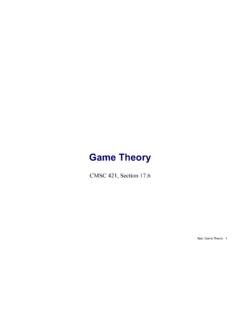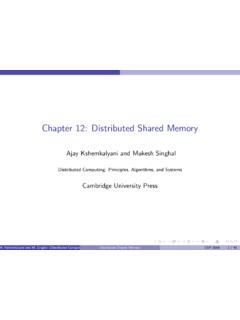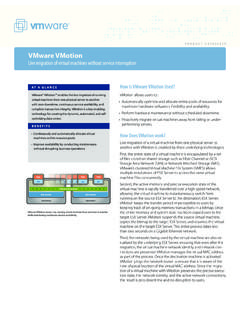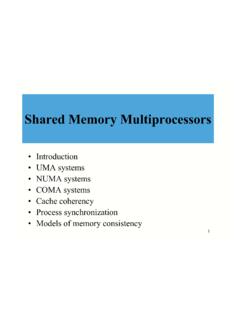Transcription of JSR-133: JavaTM Memory Model and Thread Specification
1 JSR-133: JavaTM Memory Model and Thread Specification August 24, 2004, 4:42pm This document is the JSR-133 specification, the JavaTM Memory Model and Thread Specification (JMM), as developed by the JSR-133 expert group. This specification is part of the JSR-176. umbrella for the Tiger ( ) release of the JavaTM platform, and the normative contents of this specification will be incorporated into The JavaTM Language Specification (JLS), The JavaTM . Virtual Machine Specification (JVMS), and the specification for classes in the package. This JSR-133 specification will not be further maintained or changed through the JCP.
2 All future updates, corrections and clarifications to the normative text will occur in those other documents. The normative contents of this specification are contained in Sections 5, 7, , , 11, 12, 14, 15 and 16. The other sections, as well as portions of the above mentioned sections, contain non-normative text that is intended to explain and clarify the normative text. In case of a conflict between the normative text and the non-normative text, the normative text stands. The discussion and development of this specification has been unusually detailed and technical, involving insights and advances in a number of academic topics.
3 This discussion is archived (and continues) at the JMM web site. The web site provides additional information that may help in understanding how this specification was arrived at; it is located at pugh/java/memoryModel That web site and mailing list will continue to be updated and maintained, and further updates and expansion of non-normative text intended to help people understand the JSR-133 specification will be available from that web site. Two changes from the original specification in the JLS are most likely to require that JVMTM. implementations be changed: The semantics of volatile variables have been strengthened to have acquire and release se- mantics.
4 In the original specification, accesses to volatile and non-volatile variables could be freely ordered. The semantics of final fields have been strengthened to allow for Thread -safe immutatability without explicit synchronization. This may require steps such as store-store barriers at the end of constructors in which final fields are set. 1. Contents 1 Introduction 5. Locks .. 5. Notation in Examples .. 5. 2 Incorrectly Synchronized Programs Exhibit Surprising Behaviors 6. 3 Informal Semantics 7. Sequential Consistency .. 9. Final Fields .. 9. 4 What is a Memory Model ?
5 11. 5 Definitions 11. 6 Approximations to a Java Memory Model 13. Sequential Consistency Memory Model .. 13. Happens-Before Memory Model .. 14. Causality .. 14. Happens-Before is too Weak .. 14. Causality is Subtle .. 15. An Approach to Causality .. 16. 7 Formal Specification of the Java Memory Model 17. Actions and Executions .. 17. Definitions .. 18. Well-Formed Executions .. 18. Causality Requirements for Executions .. 19. Observable Behavior and Nonterminating Executions .. 20. 8 Illustrative Test Cases and Behaviors 21. Surprising Behaviors Allowed by the Memory Model .
6 22. Behaviors Prohibited by the Memory Model .. 24. 9 Final Field Semantics 25. Goals and Requirements for Final Field Semantics .. 25. Post-Construction Modification of Final Fields .. 26. Formal Semantics of Final Fields .. 27. Final Field Safe Contexts .. 27. Replacement and/or Supplemental Ordering Constraints .. 27. Static Final Fields .. 28. JVM Rules For Final Field Use .. 28. 10 Illustrative Test Cases and Behaviors of Final Fields 29. 11 Word Tearing 32. 12 Non-atomic Treatment of double and long 32. 2. 13 Fairness 35. 14 Wait Sets and Notification 36.
7 Wait .. 36. Notification .. 37. Interruptions .. 37. Interactions of Waits, Notification and Interruption .. 38. 15 Sleep and Yield 38. 16 Finalization 39. Implementing Finalization .. 40. Interaction with the Memory Model .. 41. 3. List of Figures 1 Surprising results caused by statement reordering .. 6. 2 Surprising results caused by forward substitution .. 7. 3 Ordering by a happens-before relationship .. 8. 4 Example illustrating final field semantics .. 10. 5 Without final fields or synchronization, it is possible for this code to print /usr.
8 10. 6 Violations Allowed by the Happens-before Memory Model .. 15. 7 An unacceptable violation of causality .. 15. 8 Effects of Redundant Read Elimination .. 16. 9 Using Global Analysis .. 16. 10 A standard reordering .. 22. 11 Table of commit sets for Figure 10 .. 22. 12 An unexpected reordering .. 22. 13 Effects of redundant read elimination .. 23. 14 Writes can be performed early .. 23. 15 Compilers can think hard about when actions are guaranteed to occur .. 24. 16 A complicated inference .. 24. 17 Can Threads 1 and 2 see 42, if Thread 4 didn't write 42?
9 24. 18 Can Threads 1 and 2 see 42, if Thread 4 didn't write to x? .. 25. 19 Example of reordering of final field reads and reflective change .. 26. 20 Final field example where reference to object is read twice .. 29. 21 Memory chains in an execution of Figure 20 .. 30. 22 Transitive guarantees from final fields .. 30. 23 Memory chains in an execution of Figure 22 .. 31. 24 Yet another final field example .. 32. 25 Memory chains in an execution of Figure 24 .. 33. 26 Bytes must not be overwritten by writes to adjacent bytes .. 34. 27 Lack of fairness allows Thread 1 never to surrender the CPU.
10 35. 28 If we observe print message, Thread 1 must see write to v and terminate .. 35. 4. 1 Introduction JavaTM virtual machines support multiple threads of execution. Threads are represented by the Thread class. The only way for a user to create a Thread is to create an object of this class; each Thread is associated with such an object. A Thread will start when the start() method is invoked on the corresponding Thread object. The behavior of threads, particularly when not correctly synchronized, can be confusing and counterintuitive. This specification describes the semantics of multithreaded programs written in the JavaTM programming language; it includes rules for which values may be seen by a read of shared Memory that is updated by multiple threads.


















